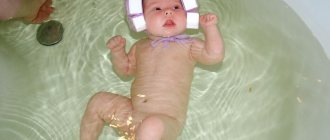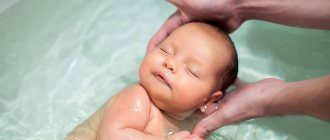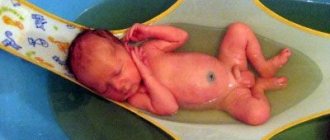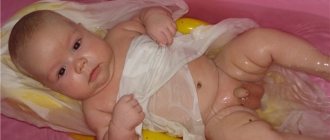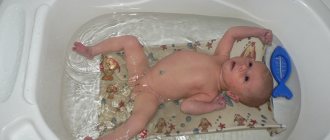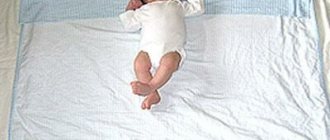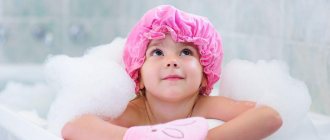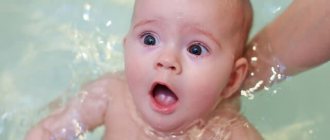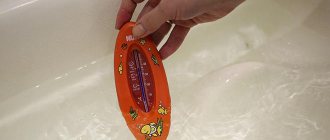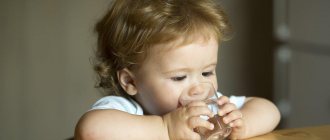At what age can children swim?
Water procedures in the bathroom should begin at 6 months of age. If the baby’s health is not weakened by cardiovascular diseases, he can easily adapt to any conditions. During the adaptation process, the child may experience a decrease in appetite.
It is better to introduce a child to the sea or river no earlier than 2 years of age. You should not suddenly bring it into the water, as it may be frightened by large volumes of water. Just 10-15 minutes on the shore will help you show your baby that relaxing on the water is an interesting activity. In general, until the age of 3, children have no fear of water, this allows them to consolidate the skills of confidently staying on the water and swimming well.
To harden or not?
No one doubts the benefits of hardening and its positive effect on the baby’s immunity. Some advise bathing even the smallest at 25-26 degrees. In fact, newborns not only do not need this, but sometimes it is harmful: too cold water can harm the child and discourage any interest in water procedures. It is better to wait a couple of months with hardening until the thermoregulation mechanisms are formed. If you want to start now, you need to start at 36-37 degrees and cool the water by 1-2 degrees every 3-4 days. But in any case, the air temperature in the room where the baby is bathed must be at least 27 degrees so that the baby does not freeze.
But the most important thing in bathing is to listen to the baby himself, because his needs and opinions may not coincide with the theories of pediatricians!
The first bath is not scary!
Do you want to be the first to read our materials? Subscribe to our telegram channel, Facebook page, or VKontakte group.
We are at Yandex.Zen - join us!
How long can you be in the water?
Bath time is a hotly debated topic among parents. The ban on long stays in water is strictly condemned by Dr. Evgeniy Komarovsky. He claims that it is the parents' prohibitions that lead to swimming until the blue. Without coercion, the child himself will develop an internal timer, by which he will determine the required amount of time in the water.
It is recommended to bathe children under 5 years of age in stages. To begin, take 2-3 short dives. Initially, the first procedures should last no more than 3 minutes. You should avoid going to the pond during periods of strong solar activity. The risk of heatstroke increases between 10:00-12:00 and 16:00-19:00. Children under 5 years old should not be in the water for more than 5 minutes at a time.
Why is it important to monitor the water temperature?
Starting from the first time, bathing for a baby becomes a daily ritual. The first hygiene procedures of this nature last only a few minutes. But over time, the baby spends more and more time in the water, so the process should become comfortable for the little one, calm him down after a day full of new impressions and give him joy.
The processes of thermoregulation in the body of a small child are not yet as streamlined as in an adult. That is why the wrong water temperature when bathing a newborn for the first and subsequent times can cause overheating or, on the contrary, hypothermia of the child. It is important to understand the effect of water of different temperatures on the baby’s skin and take this into account when bathing:
- Hot water steams the skin and helps open the pores. Yes, it stimulates the development of the epidermis well. But he is still very young and does not know how to protect himself from infections. Therefore, open pores are vulnerable to bacteria.
- Cold water narrows the pores, but provokes spasms of small vessels. This can harm the toddler’s urinary system and cause some discomfort during subsequent urination.
Choosing a reservoir
When choosing areas for recreation on the water, pay attention to the quality of the environment. The water should be clear and running. There should not be any production, food or processing industry facilities in the beach area. Otherwise, the water will be contaminated and filled with organic matter. The best solution for your first acquaintance would be to choose the sea.
An inflatable pool will serve as an analogue of summer water procedures. A container of 1 meter in diameter is sufficient. The product must have a comfortable side. The water in the container is changed as it heats up.
Permissible pool height:
- from 6 months to 2 years - up to 15-20 cm;
- period 2-3 years - about 50 cm;
- from 3 to 7 years - 50-70 cm.
It is recommended to give preference to splash pools with an inflatable bottom. It provides bounce, springs and creates a warm layer of air.
Permissible water and air temperature
In open spaces, swimming with your baby is allowed in dry and windless weather. Acceptable water temperature is 22-23°C. In this case, the air should be heated to 25-26°C. It is worth considering that at least 1-1.5 hours should pass between eating and bathing.
First bath - tips for parents
In order for the baby to love hygiene and benefit his health, it is important for young parents to follow simple recommendations in this simple matter:
- It is important not only to prepare water at the correct temperature. It is important that the room in which you bathe your newborn has the appropriate air temperature. And this is at least +25°C, but not more than +27°. This way the baby won't catch a cold.
- There should also be no drafts in this room. However, it is still worth airing it before bathing.
- Use hygiene products intended for children from 0. At the same time, they should contain a minimum of dyes and fragrances, and it is better to generally choose products that are neutral in color and smell.
- Before bathing, undress your baby and let him lie naked for a while. Air baths are no less useful than water baths. You can also do light massage and gymnastics for newborns.
- Accompany the entire procedure with rhymes and nursery rhymes. This will make bath time a fun activity that your newborn will love. And this is the first step towards instilling in your child good habits and a love of personal hygiene.
- From a month on, while the baby is in the water, you can periodically “move” him into an adult bathtub, performing simple water gymnastics exercises. And from 3-4 months you can slowly teach your baby swimming movements and holding his breath.
Remember, the bathing procedure should be pleasant and joyful not only for the child, but also for you. In fact, this is the first game you can play with your little miracle.
What viruses and infections in water are dangerous for children?
Water-related diseases in adults and children mainly concern colds. Hypothermia can lead to a severe cold. Water getting into the ear canals is often the cause of otitis media. Swallowing raw water will cause digestive upset. Allergic reactions may occur to algae and organic matter.
Polluted water is a source of harmful single-celled, flagellated and fungal microorganisms. When they enter the mucous membrane or digestive tract, they become pathogens of viral hepatitis, helminthiasis and leptospirosis.
Why is bathing a newborn baby more than a hygiene procedure?
For a child, every contact with water is a new emotional experience and an important procedure for strengthening the immune system. Bathing allows you to:
- regularly care for your child’s skin;
- train the thermoregulatory function of the baby’s body;
- let your child explore the world through interaction with water;
- calm the baby, which is especially valuable before going to bed;
- experience a special act of intimacy between a child and parents.
Should I bathe a child with an umbilical wound and how often should I take a bath?
Some pediatricians do not advise bathing the baby in a bath until the umbilical wound heals (usually this process takes two to three weeks), and suggest parents get by with wiping with a damp cloth or special wipes. For example, “My Sunshine” baby wipes are suitable and can be used from the first day of life.
Other experts, on the contrary, suggest starting bathing on the first day after discharge. Parents need to choose when their baby should start taking water treatments. It is better to rely on the recommendations of your pediatrician.
In Soviet times, many parents preferred to bathe their babies from the first days of life, adding a weak solution of potassium permanganate. With any additives, be it potassium permanganate or herbs, you need to be extremely careful. Sometimes potassium permanganate crystals do not completely dissolve when exposed to water and cause burns on the skin of a newborn. It is much safer to replace the manganese solution with a weak infusion of string, or even better, with cosmetics with natural herbal extracts.
When is it absolutely forbidden to arrange water procedures?
If the baby is sick and experiences an acute period of illness, for example, with a high fever. The doctor will advise when to resume full hygiene procedures, and will allow bathing when the baby begins to recover.
How often should water treatments be performed on a newborn up to one month old?
It is important to stay clean throughout the day. But pediatricians recommend bathing your baby with foam once or twice a week. For up to a year, two or three baths per week are sufficient.
How will the procedure for bathing a newborn change with age?
Many parents swaddle a child up to one and a half months old before bathing. This will make it easier for the baby to tolerate the difference in air and water temperatures.
In the period from one and a half to three months, the baby can bathe, lying in a baby bath with a small amount of water at a comfortable temperature for him (on average - 37-38 degrees).
From three months, when the baby becomes more mobile, parents can practice bathing together in a large bathtub. At the same time, you can purchase an inflatable ring for your baby.
A child over six months old is interested in actively exploring the world and playing with water. A special high chair is useful for bathing at this age. This way the game is combined with useful procedures.
Safety precautions
- Do not leave your child unattended, even if he is confident in the water.
- The reservoir level should not reach the baby’s chin.
- Keep the temperature difference under control; an overheated child should not suddenly enter cold water.
- Choose comfortable clothes for swimming, and wear a hat on the shore.
- Use sunscreen for children.
- Children under 3 years old are strictly prohibited from staying in the open sun for more than 10 minutes.
- Check inflatable products before going to the beach; fasteners and plugs should be out of the child’s attention.
By being careful and carefully choosing a body of water, you will ensure that your baby has a happy acquaintance with water. Active outdoor recreation strengthens the immune system and affects the harmonious development of the muscular system.
doctor Find out more
Try to learn more
Bathing in the bath
Doctors advise bathing the child in water at a temperature of 37°C, since the baby was in the same water temperature as in the amniotic sac. The water temperature must be maintained the entire time the newborn is bathed (15-30 minutes). You need to periodically check the water with your elbow by dipping it into the bath. And add more if the water gets cold. Most mothers use this method. To correctly determine the water temperature, you should pay attention to the sensations and describe them on this scale:
- 5°C – the water feels like ice;
- 15-20°C – the water feels cold;
- 37°C – the skin does not experience any sensations in water;
- 40-45°C – pleasant and warm sensations are experienced;
- 60-65°C – hot water, but acceptable for bathing an adult.
But it is best to protect the child and rely on the thermometer readings. Selecting a thermometer
The thermometer should not be glass, as there is a risk of breaking it in the bath if handled carelessly. Small particles of glass or chemical liquid may get into your baby's water. The thermometer should be able to be attached to the bath at a depth of 10-30 centimeters. It is important to maintain the temperature of the water for the bathing period with complete accuracy. But with each new bath, it is advised to lower the water temperature by 0.1°C so that the child does not notice the changes. You need to bring the water temperature to 21-26°C. This gives the child the opportunity to harden himself.
